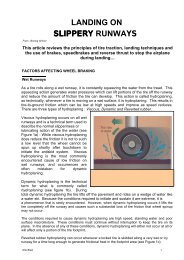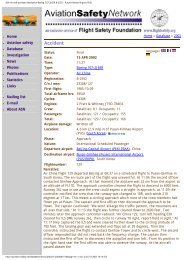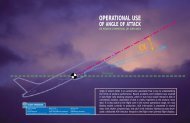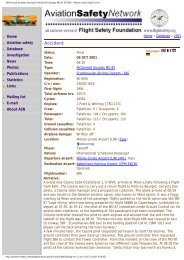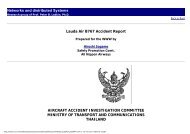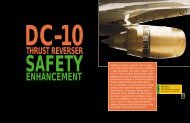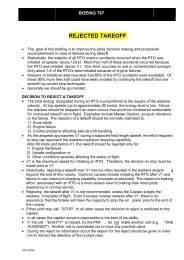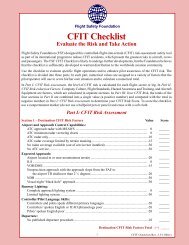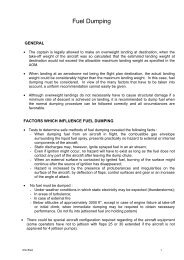Boeing 737-236 series 1, G-BGJL: Main document - Leonardo
Boeing 737-236 series 1, G-BGJL: Main document - Leonardo
Boeing 737-236 series 1, G-BGJL: Main document - Leonardo
You also want an ePaper? Increase the reach of your titles
YUMPU automatically turns print PDFs into web optimized ePapers that Google loves.
A check on the hardness of the CCOC in the vicinity of the bulgedarea suggested that temperatures<br />
of up to 930°C had beenexperienced by the casing, at which temperatures the materialproperties<br />
would have been significantly impaired.<br />
The fuel nozzles from engine P 702868 were tested against themanufacturer's specifications for<br />
both the flow rate and flowpattern, which could affect the local heat distribution and thusthe level<br />
of distress felt by the can. The conclusion of the testswas that they did not reveal any functional<br />
discrepancies comparedwith in-service standards.<br />
The No 9 nozzle exhibited heavy wear of the outside diameter ofthe nozzle nut where it engages in<br />
the No 9 can, consistent withexcessive movement of the can relative to the nozzle having<br />
occurredafter the dome section had separated from the rest of the can.<br />
The FCU was examined to check its serviceability and settings.Whilst the unit had suffered some<br />
fire damage, it was still possibleto bench test it and to extract various parameters relevant tothe<br />
accident. In particular, it was found that there was no evidenceto support a lack of 'idle speed<br />
repeatability' - ie failure tomaintain an idle speed setting. The condition of the unit wasgenerally as<br />
might be expected from a unit with about 15,000 hourssince last bench calibration. The idle trim<br />
screw was found aboutmid-way in its 22-turn range. It was concluded that the unit wascapable of<br />
running a JT8D-15 engine throughout its operationalrange.<br />
FDR evidence indicated that both the right and left reverser systemsdeployed normally, but that<br />
only the right reverser retractedagain into the stowed position; the left reverser remained<br />
fullydeployed.<br />
The left reverser mechanism had suffered general fire damage,resulting in partial seizure of the<br />
feedback mechanism and stiffnessof the lock mechanisms. The operating cable and interlock<br />
systemmounted in the wing above the pylon were also affected by thefire. The retraction<br />
mechanism operated satisfactorily when thehydraulic system was pressurised by means of a hand<br />
pump, andthe only evidence of abnormality was stiffness of the variouslinkages as a result of the<br />
fire.<br />
Analysis of the flight recorder data from preceding flights showedthat the left engine oil pressure<br />
typically decayed to 35 psiat an N2 of 26% (the oil pressure switch which inhibits the thrustreverser<br />
actuating system is set to trip at a nominal 35 psi).Recorder data for the accident flight indicates<br />
that the leftengine oil pressure fell below this value 3 seconds after thereverser had deployed, but<br />
approximately 6.5 seconds before reversethrust was de-selected (assuming right and left reverse<br />
were de-selectedtogether), de-activating the operating system before reverse wascancelled.<br />
1.12.2.2 Fire (Appendix 8 Figs a-b)<br />
Fuselage<br />
The whole of the rear fuselage aft of seat row 19 had collapsedonto the ground as a result of<br />
external fire attack on the fuselagelower skin and longerons between frames 867 and 907, and<br />
firedamage to the cabin floor structure which led to floor collapseover much of the area above the<br />
aft cargo hold. Aft of the wingtrailing edge, between seat row 14 and the rear entrance vestibule,the<br />
fuselage was partially destroyed by a combination of externaland internal fire. The greatest damage<br />
was concentrated on theleft side in the vicinity of the aft baggage hold.<br />
Empennage



